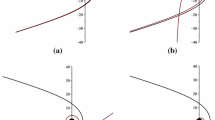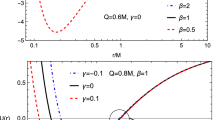Abstract
Considering electrically charged test particles, we continue our study of the exterior dynamics of a charged Weyl black hole which has been previously investigated regarding the motion of mass-less and (neutral) massive particles. In this paper, the deflecting trajectories of charged particles are designated as being gravitationally Rutherford-scattered and detailed discussion of angular and radial particle motions is presented.







Similar content being viewed by others
Notes
In this paper, we work in the geometric unit system, by considering \(G=c=1\). Accordingly, the dimensions of mass, electric charge and length are given in meters.
By definition, we have [54]
$$\begin{aligned} \ss (x) \equiv y = \int _x^\infty \frac{\mathrm {d}{\mathfrak {t}}}{\sqrt{4{\mathfrak {t}}^3-g_2 {\mathfrak {t}}-g_3}}. \end{aligned}$$Then, the inverse function \(x = \wp (y,g_2,g_3)\equiv \wp (y)\) defines the elliptic Weierstra\(\ss \) \(\wp \) function with the coefficients \(g_2\) and \(g_3\), for which
$$\begin{aligned} \wp '(y)\equiv \frac{\mathrm {d}}{\mathrm {d}y}\wp (y) = - \sqrt{4\wp ^3(y)-g_2\wp (y)-g_3}. \end{aligned}$$The two other related functions, namely the Weierstra\(\ss \) Zeta and Sigma functions, are defined as
$$\begin{aligned} \zeta (y)= & {} -\int \wp (y)\mathrm {d}y,\\ \sigma (y)= & {} e^{\int \zeta (y)\mathrm {d}y}. \end{aligned}$$For two vectors \(\varvec{x}\) and \(\varvec{y}\), we notate \(\varvec{x}\cdot \varvec{y}=g_{\mu \nu } x^\mu y^\nu \).
The norm of a vector \(\varvec{X}\) is defined as \(||\varvec{X}||\doteq \sqrt{\varvec{X}\cdot \varvec{X}}\).
References
C.W. Misner, K.S. Thorne, J.A. Wheeler, Gravitation (Princeton University Press, Princeton, 2017)
J.A.H. Futterman, F.A. Handler, R.A. Matzner, Scattering from Black Holes, Cambridge Monographs on Mathematical Physics (Cambridge University Press, Cambridge, 1988)
S. Chandrasekhar, The Mathematical Theory of Black Holes, Oxford Classic Texts in the Physical Sciences (Oxford University Press, Oxford, 2002)
E. Poisson, A. Pound, I. Vega, Liv. Rev. Rel. 14, 7 (2011), arXiv:1102.0529 [gr-qc]
L. Blanchet, A. Spallicci, B. Whiting, Mass and Motion in General Relativity, Fundamental Theories of Physics Book Series (Springer, Dordrecht, 2011)
J. Bicak, Z. Suchlik, V. Balek, Bull. Astron. Inst. Czechoslov. 40, 65 (1989)
V. Karas, D. Vokrouhlicky, Class. Quantum Gravity 7, 391 (1990)
A.N. Aliev, N. Özdemir, Mon. Not. R. Astron. Soc. 336, 241 (2002), https://academic.oup.com/mnras/article-pdf/336/1/241/18419356/336-1-241.pdf
D. Pugliese, H. Quevedo, R. Ruffini, Phys. Rev. D 83, 104052 (2011)
M. Olivares, J. Saavedra, C. Leiva, J.R. Villanueva, Modern Phys. Lett. A 26, 2923 (2011). arXiv:1101.0748 [gr-qc]
M. Fathi, Chin. Phys. C 37, 025101 (2013)
E. Hackmann, H. Xu, Phys. Rev. D 87, 124030 (2013)
Y.-K. Lim, Phys. Rev. D 91, 024048 (2015)
A. García, E. Hackmann, J. Kunz, C. Lämmerzahl, A. Macías, J. Math. Phys. 56, 032501 (2015)
D. Pugliese, H. Quevedo, R. Ruffini, Eur. Phys. J. C 77, 206 (2017), arXiv:1304.2940 [gr-qc]
P. Das, R. Sk, S. Ghosh, Eur. Phys. J. C 77, 735 (2017), arXiv:1609.04577 [gr-qc]
Sehrish Iftikhar, EPJ Web Conf. 168, 04006 (2018)
J. Vrba, A. Abdujabbarov, M. Kološ, B. Ahmedov, Z.C.V. Stuchlík, J. Rayimbaev, Phys. Rev. D 101, 124039 (2020)
S.U. Khan, J. Ren, Chin. J. Phys. (2020). https://doi.org/10.1016/j.cjph.2020.08.027
M. Yi, X. Wu, Phys. Scr. 95, 085008 (2020)
A. Abdujabbarov, J. Rayimbaev, F. Atamurotov, B. Ahmedov, Galaxies 8, 76 (2020). https://doi.org/10.3390/galaxies8040076
R. Javlon, D. Alexandra, U. Camci, A. Abdujabbarov, B. Ahmedov, arXiv e-prints (2020), arXiv:2010.04969 [gr-qc]
M. Anacleto, F. Brito, J. Campos, E. Passos, Phys. Lett. B 810, 135830 (2020)
J.R. Villanueva, M. Olivares, Eur. Phys. J. C 75, 562 (2015), arXiv:1510.08340 [gr-qc]
S. Sarkar, F. Rahaman, I. Radinschi, T. Grammenos, J. Chakraborty, Adv. High Energy Phys. 2018, 5427158 (2018)
Q.-Q. Zhao, Y.-Z. Li, H. Lü, Phys. Rev. D 98, 124001 (2018)
P.A. González, M. Olivares, E. Papantonopoulos, Y. Vásquez, Phys. Rev. D 97, 064034 (2018)
S. Shaymatov, J. Vrba, D. Malafarina, B. Ahmedov, Z. Stuchlík, Phys. Dark Universe 30, 100648 (2020)
B. Narzilloev, J. Rayimbaev, S. Shaymatov, A. Abdujabbarov, B. Ahmedov, C. Bambi, Phys. Rev. D 102, 044013 (2020)
Z. Stuchlík, M. Kolos, Eur. Phys. J. C 76, 32 (2016)
Z. Stuchlík, M. Kološ, J. Kovář, P. Slaný, A. Tursunov, Universe 6, 26 (2020). https://doi.org/10.3390/universe6020026
A. Tursunov, Z. Stuchlík, M. Kološ, N. Dadhich, B. Ahmedov, Astrophys. J. 895, 14 (2020)
D.V. Gal’tsov, J. Phys. A Math. Gen. 15, 3737 (1982)
A. Tursunov, M. Kološ, Z. Stuchlík, D.V. Gal’tsov, Astrophys. J. 861, 2 (2018)
G.-R. Chen, Y.-C. Huang, Phys. Lett. B 792, 86 (2019)
P.D. Mannheim, D. Kazanas, Astrophys. J. 342, 635 (1989)
D. Kazanas, P.D. Mannheim, Astrophys. J. Suppl. Ser. 76, 431 (1991)
P.D. Mannheim, arXiv e-prints (2007), arXiv:0707.2283 [hep-th]
P.D. Mannheim, Found. Phys. 37, 532 (2007)
M. Pawłowski, R. Raczka, Found. Phys. 24, 1305 (1994)
V.C. Rubin, W.K. Ford Jr., N. Thonnard, Astrophys. J. 238, 471 (1980)
Y. Yoon, Phys. Rev. D 88, 027504 (2013)
P.D. Mannheim, Phys. Rev. D 93, 068501 (2016)
P.D. Mannheim, Prog. Part. Nucl. Phys. 56, 340 (2006), arXiv:astro-ph/0505266 [astro-ph]
P.D. Mannheim, D. Kazanas, Phys. Rev. D 44, 417 (1991)
F. Payandeh, M. Fathi, Int. J. Theor. Phys. 51, 2227 (2012), arXiv:1202.2415 [gr-qc]
M. Fathi, M. Olivares, J.R. Villanueva, Eur. Phys. J. C 80, 51 (2020)
M. Fathi, J.R. Villanueva, arXiv e-prints (2020), arXiv:2009.03402 [gr-qc]
M. Fathi, M. Kariminezhaddahka, M. Olivares, J.R. Villanueva, Eur. Phys. J. C 80, 377 (2020)
B. Carter, Commun. Math. Phys. 10, 280 (1968)
Z. Stuchlík, Bull. Astron. Inst. Czechoslov. 34, 129 (1983)
Z. Stuchlík, S. Hledík, Phys. Rev. D 60, 044006 (1999)
N. Cruz, M. Olivares, J.R. Villanueva, Class. Quantum Gravity 22, 1167 (2005), arXiv:gr-qc/0408016 [gr-qc]
P. Byrd, M. Friedman, Handbook of Elliptic Integrals for Engineers and Scientists, Grundlehren der mathematischen Wissenschaften (Springer, Berlin, 1971)
Y. Zel-dovich, I. Novikov, Stars and Relativity, Dover Books on Physics (Dover Publications, New York, 2014)
L. Ryder, Introduction to General Relativity (Cambridge University Press, Cambridge, 2009)
R. Penrose, Phys. Rev. Lett. 14, 57 (1965)
S.W. Hawking, Phys. Rev. Lett. 15, 689 (1965)
S.W. Hawking, Phys. Rev. Lett. 17, 444 (1966)
R. Penrose, Gen. Relativ. Gravit. 7, 1141 (2002)
A. Raychaudhuri, Phys. Rev. 98, 1123 (1955)
S. Kar, S. SenGupta, Pramana 69, 49 (2007), arXiv:gr-qc/0611123
A. Balakin, J.W. van Holten, R. Kerner, Class. Quantum Gravity 17, 5009 (2000)
M. Heydari-Fard, S. Fakhry, S. Hasani, Adv. High Energy Phys. 2019, 1879568 (2019), arXiv:1905.08642 [gr-qc]
R.M. Wald, General Relativity (Chicago University Press, Chicago, 1984)
E. Poisson, A Relativist’s Toolkit: The Mathematics of Black-Hole Mechanics (Cambridge University Press, Cambridge, 2004)
F. Pirani, Acta Phys. Polon. 15, 389 (1956)
S.L. Bażański, J. Math. Phys. 30, 1018 (1989)
H. Weyl, Ann. Phys. 359, 117 (1917). https://doi.org/10.1002/andp.19173591804
S.D. Majumdar, Phys. Rev. 72, 390 (1947)
A. Papapetrou, Proc. R. Irish Acad. Sect. A Math. Phys. Sci. 51, 191 (1945)
B.S. Guilfoyle, Gen. Relativ. Gravit. 31, 1645 (1999), arXiv:gr-qc/9906089
J.P.S. Lemos, V.T. Zanchin, Phys. Rev. D 81, 124016 (2010)
J.P.S. Lemos, V.T. Zanchin, Phys. Rev. D 77, 064003 (2008)
J.P.S. Lemos, V.T. Zanchin, Phys. Rev. D 80, 024010 (2009)
P.D. Mannheim, D. Kazanas, Print-90-0363 (CONNECTICUT) (1990)
P. Mannheim, Ann. N. Y. Acad. Sci. 631, 194 (1991). https://doi.org/10.1111/j.1749-6632.1991.tb52643.x
T.G. Cardano, E.T.R. Witmer, The Rules of Algebra: (Ars Magna) (Dover Publications, Inc., New York, 1993)
R.W.D. Nickalls, Math. Gazette 90, 203–208 (2006)
I. Zucker, Math. Gazette 92, 264 (2008)
Acknowledgements
M. Fathi has been supported by the Agencia Nacional de Investigación y Desarrollo (ANID) through DOCTORADO Grant No. 2019-21190382 and No. 2021-242210002. J.R. Villanueva was partially supported by the Centro de Astrofísica de Valparaíso (CAV).
Author information
Authors and Affiliations
Corresponding author
Appendices
Appendix A: The method of finding \(L_U\) in Eq. (38)
Equation (34) allows for obtaining an expression for \(L_U\), by solving
in which
Solving Eq. (A1) for \(L_{U}^2\) then yields the value in Eq. (38).
Appendix B: Finding the angular equation of motion
Since the closest approach happens at \(r_S\), to deal with the integral in Eq. (46), we define the following nonlinear change of variable:
which reduces Eq. (46) to
where \(u_j\doteq {1\over (r_j/r_S)-1}\), with \(j=\{2,3,5,6\}\), and
with
Defining
and applying another change of variable
we can rewrite Eq. (B2) as
given that \(U_3 = \frac{1}{4}\left( u_3+\frac{{\mathbf {a}}}{3}\right) \), and
Direct integration of Eq. (B7) results in the expression in Eq. (48).
Appendix C: Solving depressed quartic equations
The condition \(V_r'(r)=0\) provides the following equation of eighth degree:
To solve this equation, we firstly make the change of variable \(r^2\doteq x\). Afterward, we combine the methods of Ferrari and Cardano to solve a depressed quartic equation of the form (originally studied by Cardano in Ref. [78])
This equation can be rewritten as the product of two quadratic equations, as follows:
Accordingly, we obtain
Solving the first two equations for \({{\tilde{\beta }}}\) and \({{\tilde{\gamma }}}\) yields
which together with Eq. (C4c) results in an equation of sixth degree in \({{\tilde{\alpha }}}\):
Applying the change of variable
we obtain the depressed cubic equation
where
The real solution to this cubic equation is obtained as [79, 80]
Therefore, the roots of Eq. (C2) are
Appendix D: Solving the equation of motion for frontal scattering
Equation (66) can be recast as
in which
Considering \(r_s\) as the initial position, we can rewrite Eq. (D1) as
which by the linear change of variable
reduces to
where
and
Now, letting
yields the following reduced integral form of Eq. (D5):
in which
Applying the last change of variable
we get
where we have defined
The direct integration of the elliptic integral in Eq. (D12) now results in the expression in Eq. (72).
Rights and permissions
About this article
Cite this article
Fathi, M., Olivares, M. & Villanueva, J.R. Gravitational Rutherford scattering of electrically charged particles from a charged Weyl black hole. Eur. Phys. J. Plus 136, 420 (2021). https://doi.org/10.1140/epjp/s13360-021-01441-9
Received:
Accepted:
Published:
DOI: https://doi.org/10.1140/epjp/s13360-021-01441-9




